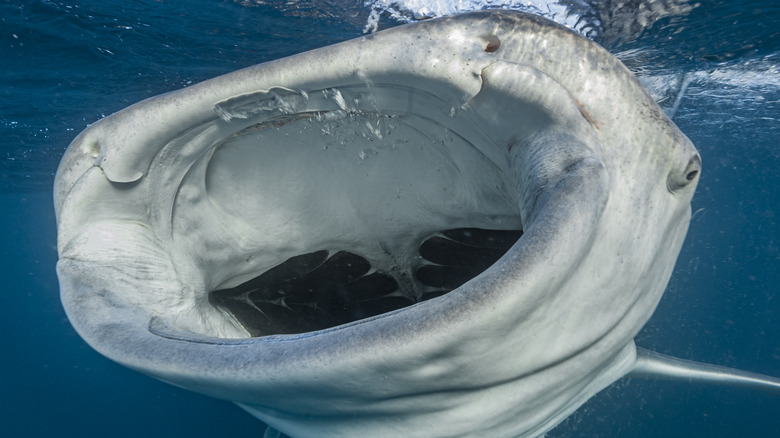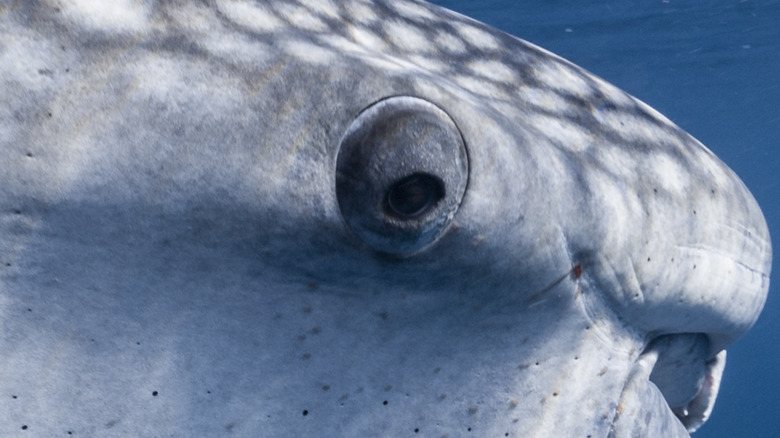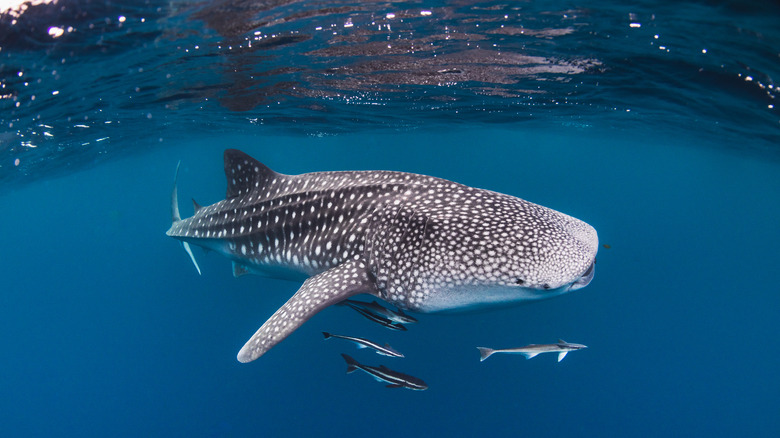Whale Sharks Have Teeth Where You Might Not Expect Them
Whale sharks are some of the craftiest swimmers in the deep blue sea. Growing to lengths of approximately 50 feet, they currently hold the title of the largest fish in the world, as Smithsonian Magazine writes. From tail to gill, the whale shark is distinct both in its body structure and behavior. It is one of only three identified types of filter-feeding sharks, meaning that while it looks menacing it is mostly innocuous, preferring tiny fish and plankton to tasty human morsels (per Britannica).
The whale shark's non-threatening presence in the tropical oceans, where it dwells, is concealed by its gaping mouth which opens 5 feet wide to reveal 300 rows of teeth, according to Live Science. Its peculiar physique is further elaborated by its flat wide head, checkerboard stripes, and sensory organs dangling out of each nostril of its protruding snout. It's safe to say that this gentle giant is a frightening sight to behold, but in a more gruesome revelation, most of its teeth aren't even in its mouth. They're someplace much more unexpected.
Approximately 3,000 teeth in each eyeball
It's easy to think of the whale shark as harmless when your feet are safely planted in the sand. Perhaps for some this thought could still hold water when scuba diving up close and watching the massive fish devour plankton like a vacuum cleaner sucking in cereal. But, a closer look at one of their massive eyeballs (pictured above) and the knowledge that it could contain more than a jaw-dropping 3,000 leaf-shaped molars is something else entirely (via PLOS One).
An extensive 2020 study led by renowned researcher Taketeru Tomita and several colleagues yielded shocking results when the bodies of live and dead whale sharks were thoroughly examined. As it turns out, whale sharks possess the unique attribute of eye armor which comes in the form of thousands of tiny teeth. According to Smithsonian Magazine, these jagged little teeth, scientifically referred to as "eye denticles" protect the sharks' vision in lieu of eyelids, which the whale shark mysteriously lacks. Talk about keeping your eyes peeled.
Whale sharks can also tuck their eyeballs in their skulls
Carrying a mouthful of teeth in each eyeball is just one of this maritime creature's extraordinary talents. Newsweek reports that, in addition to being the only known elasmobranch (science speak for stingrays, skates, and sharks) to possess eye denticles, the whale shark also has a set of rotating, retractable eyes they can push right into the back of their skull. If you have teeth on your brain now, you can rest at ease that you're not the only one. The whale shark apparently has teeth on his brain relatively often, whenever he is inclined to make use of this retractable feature.
According to Smithsonian Magazine, scientists previously believed the whale shark relied heavily on its sense of smell when navigating the tropical ocean waves. Future tests will likely look at the whale shark's field of vision, examining the wide array of colors those armored eyes just might be taking in.


